|
On this page: History is built upon the story Myth.
The subject of Chen 'tuan' or 'bo' or as 'master' Xi Yi, and
the topics linked to him ...and why, is a subject worth unwrapping. For the teacher Chen Tuan of the Song Dynasty, there exists
about 5 differing health and martial exercises claiming him as an origin. Use of the alternate name 'bo' would then become
significant.
For the martial exercise commonly named: 心意六合八法拳
or as secularly named: 華嶽夷希門 [ Co-joined 華嶽夷希門心意六合八法拳
], the Song Dynasties' martial arts and/ or a taoist 'school' 門 claiming standards from or lineage linked
to master xiyi- 夷希 becomes significant; to a lesser extent is Mt Hua Shan's lofty pinnacles 華嶽
[where realistically, there is no place to practice]. Also, the weather conditions, high winds and adverse snow falls,
would render Mt. Hua, even within one of its' many caves, a far less than perfect place to dwell. The martial linkage would
be alternately addressed to Song Dynasty emperor Taizu- the said creator of 'long boxing' who likely also knew the earlier
tongbei spinal reflex principle.
| Statue of Chen Tuan |
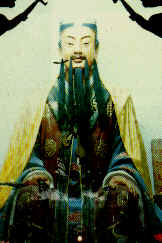
|
| 'a source' for TongBei |
| Chen Tuan imagery upon stone plaque |
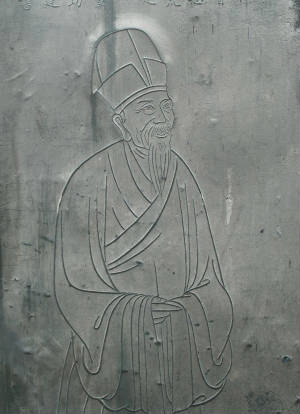
|
| inscription reversed for enhancement |
| Chen Tuan depicted on horse back |
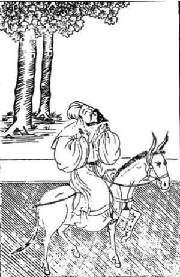
|
| ..perhaps to emulate another traveling sage |
| Popular but False Image: mythic Chen Tuan |
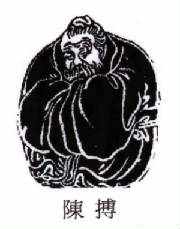
|
| From Msr Wu Yi-hui ....contracted for a carving in Guilin |
| Memorial at Yu Quan Temple on Mt Hua |
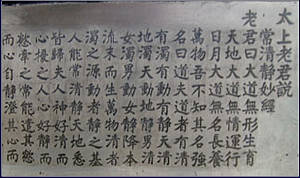
|
| Dedicated to Chen Tuan 871-989 a.d |
| Chen XiYi- stone memorial plaque [reverse image] |
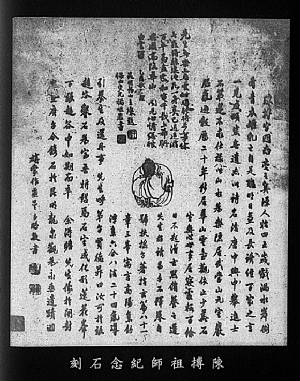
|
| Carving commissioned by LHBF teacher Wu Yi-hui |
Imagery :
All imagery of Chen [bo or tuan or xiyi] are divergent;
there exists no bonefide image. At best, Chun Tuan imagery is 'fuzzy' speculation with characteristics being derived by sectular
beliefs or event chronolgy of 'acceptable' demeaner appropriate to a 'history'. Most portray him as 'scholarly'
usually confucian or as a rotund orb; none portray him as a pugalist.
Teacher to the public Wu Yi-hui 吳翼翬 in the later part of his life, commissioned a carved
stone memorial 石刻 紀念館 陳摶 to be placed on Zhongling Shan 鍾靈山
or Guilin 桂林. Unfortunately, as often as this image has appeared on the internet, it represents no more than
just another confusing cartoon of Chen Tuan.
At best, this memorial plaque is viewed as a well-intentioned gesture, but also a misleading representations.
[ Also, I have never found this plaque on any chinese site. ]
Who are you ? 摶 tuan,
搏 bo, 博 bo
A commentary is required on Chen's names, their usage, and the confusion that does arise
if their differences are not understood.
Chen Tuan 陳摶 Chen Bo
陳搏
Daoist Chen Tuan 陳摶 has been called Chen Bo 陳搏
(or Chan Bok, in Cantonese). The two characters 摶 / 搏
look very similar..resulting in erroneous cross-over replacement.
> Tuan 摶 means
to touch [to apprehend]; also, to roll round with the hand; to roll up into a ball with the hands; a spiral or a circle [
variant of 團 ]. ie, 摶風 tuánfēng to rise very quickly.[thus quickly rising to success].
> Bo 搏 means to fight, combat, seize.
ie.
搏斗 bó dòu to wrestle, to fight, to struggle
搏动 bó dòng beat rhythmically,
throb, pulsate
肉搏 ròu pó ( n. ) hand-to-hand combat
手搏 shǒu bó ( v. ) strike
in handfight
Within the topic of martial arts, 'bo' would seem to be the better; however, within the topic of
'taoist of the Song' or geomancy, feng shui [wind / water] 'tuan' is more used. This 'tuan' and/ or 'bo' dicotomy
is a source of identity confusion in regards to Chen being a sage or an exercise teacher.
[ Note: the chief authority on Chen Tuan, is Boston University professor; Livia Kohn, Publication: Threepinespress. who generally refers to him as Chen Bo and Chen Tuan. Author Eva Wong generally refers
to Chen Po.]
Reference:
>Chen of Bo 陳博
A source for the use of Chen Bo, may have come from his said origin: Chen of Bo [this sometimes appears
as Bo Chen]. Thus..Chen 'tuan' of Po-chou, [ bo-zhou city 亳州市 'wide river'
formerly known as Bo-zhou 博州 a name of district in Anhui the capital of Yin.] Thus Chen of Bo 陳博
[ 博 陳 ] Bo-zhou City 亳州市 a prefecture-level city in northwestern Anhui province
安徽 ...China
[Not to be confused with Liaocheng, Shandong, also formerly known as Bozhou (博州).]
References:
Disambiguous Naming and Titles :
>Fu Yao Tze
扶搖子 Fuyao zi ..Master of the Whirlwind,
>Chen Tu-nan 陳 圖南, tu
nan, map of the South
[Caution. Chan To Nam confused with Chan Ho-Nam 陳浩南 ]
>Chen Chu 陳菊 , Chen of the 'flowers' [ 花 han, flower ]
as 菊花
jú huā is the chrysanthemum-flower
>Bai Yun Xian Sheng 白雲先生, white clouds 白雲
'master' ( teacher, elder, physician )
[ Note: this name could be the cause of confusion
with Bai Yuan Tong Bei Chuan, 白猿通回到拳擊
'White Ape' -Tong-Bei- 'Through-Back' Fist-Boxing . Also, the White Cloud Sect, Baiyun-zong 白雲宗, was
a popular type of Buddhist Sect.
Thus white clouds 白雲 bai yun has become entangled with white
ape 白猿 bai-yun boxing.
>Xian-Sheng Xi-Yí 先生 希夷 Named
by the 2nd Song Emperor. The choice of Xi-Yi is ellaborated further below.
Xi-yi...master 希夷先生
Significantly, he was posthumously named Xī Yí 希夷 by the second emperor of the
Song; this choice indicates some savy among the imperial scholars, as:
Chapter 14 of the Dao De Jing [ 十四章 道德經 ] says:
視之不見﹐名曰夷 = Look without seeing.. is called Yi
聽之不聞﹐名曰希
= Listen without hearing.. is called Xi
摶之不得﹐名曰微 = Feels
without touching.. is called Wei
Therefore, the emperor gave him the name Xi Yi 希夷
suggesting that Chen had reached a state as described by Dao De Jing. The princepts are with three words
Yi 夷, Xi 希 and Wei 微. Yi 夷 to represent the state of being invisible. Xi 希
to represent the state of being inaudible. Wei 微 to represent the state of being formless.
References:
Chen Tuan's name became so famous that it was also penned in as an author-source
to give credit to a writing. This was
done for the Zi Wei Dou Shu 紫微斗數 Purple Star Astrology..a form of fortune telling devised
by Taoist Lu Chun Yang 呂純陽.
References:
Other Possible Confusions:
> Chang Po-tuan 張伯端 (984-1082). Chang is best known as the founder of the Southern
branch of Ch’üan-chen Taoism, but this is a retrospective attribution, since Ch’üan-chen was not established until
decades after his death. Although Chang was initially skilled in various mantic arts, his mature doctrines were focused on
the view of the body as a universal microcosm and the arts of inner alchemy.
Reference
http://www.indiana.edu/~p374/c511/C511_15-Taoism.pdf page 9
>Chen Bu ( 陳仆; 陈卜) Chen Village its' founder, a name to not confuse.
Chen
village located at the Qingfeng mountain range, eastern Wenxian country, the village used to be called the Changyang village
over 600 years ago. According to the documents of Wenxian Country history, before Ming dynasty, there were almost no signs
of human habitation in Wenxian Country. Later on, more people from other parts moved to this place gradually, as a legend
goes until now,
"The ancestors of present Wenxian Country came from Hongtong Country, Shanxi province." Often,
Chen Bo is contested as 'not' the source of Chen Village boxing later. Chen jia gou quan 陳家溝拳
Chen Village boxing
References
http://www.tkdicandoit.com/martial-arts/tai-chi
http://www.chebucto.ns.ca/Philosophy/Taichi/chen.html
Sage's Personal Links and 'Proteges' :
<=> Emperor Taizu 太祖, 960–76
<=>
Emperor Taizong 太宗, 976–97
<=>
Fire dragon [fire dragon qigong]
<=> Li Zhi cai 李之才 [teacher of Shao Yong 邵雍 ]
<=>
Mt Hua and XiYi Sect 華嶽希夷門 <=>
WuTang Temple
Huo Lung 火 龍 'Fire Dragon' ;
aka Jia DeSheng, 賈得勝 is reputed to have traveled to and introduced a 'soft' boxing to Wu Tang; if
true, Mt.Hua is the source of principles, later exiting from Wu Tang. 武當 [Note: the use of 'wu tang' temple as an 'institute' of higher martial skills has been inserted into the historical
lineage of many claimed or acclaimed iconic sages.]
[Comment: this allegation is very spurious due to the time frames not being connected and that
there is no recorded history to support it. ]
There does exist two strands of 'history'
: (1) WuTang exercise differs from all later 'tai-chi's' and is alleged to teach a 'secret waving-hands'
form. (2) a 'visitor' entered into Chen-family village [ which is just south of Shaolin temple] and a mixing
occured with existing Chen-family village boxing-forms. How and who and when a Mt.Hua : Wu Tang link transpired
and if it has any linkage at all to Chen-family village or is a separate ancedote remains unclear. However, it is known
that aspects of Taizu-long boxing which originated during the First Song Dynasty also came into being part of the Chen Village
Boxing [not then called tai-chi-]
Wu
Tang exercise today does offer a 'Chang Sanfeng' Tai Chi- [ which is more honorific to myth Chang and previously was not called
'tai-chi' exercise] and likely the more original Tai-Yi-chuan. 武当太乙五行拳 which
has many aspects parallel to those used for LHBF.
Another: There exists also a claimed
lineage of Chen Tuan linked to Hua Shan and one of the older 'originators' of a Tai-chi- like exercise: Li
Dao Zi, or Li Tao Tsu ( 李道子 ), and the exercise, Xian Tian Quan ( 先天拳
) Before Heaven boxing. [ This is itemized on page Nota Bene at this site. ] There are however serious time line problems
about this claim stretching between dynasties.
Sage's Proteges +2 : At Yun Shan, in S.E. Lok District, a Li Dong-Feng = Lee, Tung-Fung claims to have 'discovered' documents 'in a
cave', the tomb of Chen Tuan; these are the so-called LiHe BaFa-verses; his student, Sung, Yuen-Tung is credited with elaborating
these verses in a document called five-word secrets, as each verse is of 5 characters. However, such 'wordy' secret-message
poetry is pervasive in all chinese esoteric teachings, the number of words, five or seven, is insignificant; a knowledge of
the subject matter is required for understanding.
Legacy-Largacy: Exercises :
| Drift-Dream Contemplation |
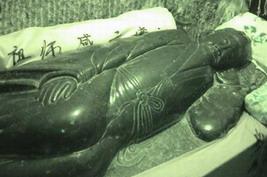
|
| Msr.Chen's forte it was said, was sleep |
Chen Tuan 'Sleep' Meditation
This recumbant 'dream-sleep' meditation tends
to take the dominant trait that characterizes Chen, master XiYi-, and is interwoven into the Mt Hua or XiYi-school practices
華山希夷門. Without going into the 'history' surrounding this skill of Chen, it is generally
refered to as 華山 十二 睡功 總訣, hua-shan shi-er shui-gong zong-jue, 'mt
hua..thirteen sleep-achievement collective-farewell [the 總訣 being a chinse idiom for imparting final knowledge
upon leaving.] A full coverage of this appears in the 'marrow of the red phoenix' 赤鳳髓 chi-feng
sui by Chou Lu-ching 周履靖 : General Instructions for the Twelve Sleep Practices of Mount Hua.
Some monks on Hua Shan continued to practice a sleeping meditation into the 1940’s on
the western peak of Hua Shan as evidenced by Hedda Morrison’s photographs taken there in 1935.
Note- See pictures at the Harvard University Library web site.
http://hcl.harvard.edu/libraries/harvard-yenching/collections/morrison/albums.html
Hua Shan album 1935 Morrison, Hedda (1908-1991), Germany, photographer
Album containing 116 black-and-white photographs
of Hua Mountain in eastern Shaanxi Sheng. Subjects include mountain landscapes, Daoist priests, monasteries, temples, altars,
temple figures, and decorative objects.
Reference:
Reference:
| Archive Vintage 1935 Photo series Hua shan |
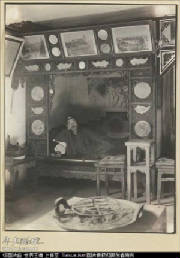
|
| Resident Monk Emulating Chen Tuan |
These are interwoven with alchemy, water-fire symbolism, kunlun,
and the Golden Flower texts
References :
Others
Associated :
Tai-Chi-Ruler:
太極尺 tai-chi-chih qigong: tai-chi-chih: Tai-ji-Ruler
Hua-Shan
KungFu: teacher Sin KwangThe: Wu-gong-named for Mt.Hua +5-animals
Hua-Shan
Qi Gong: 華山氣功 Qi-gong named for Mt.Hua, likely unrelated In researching references for HuaShan exercises/ qi-gong I came upon a site claiming to be a 'hua-shan'
exercise or a 'swimming dragon' exercise of hua-shan-qigong; ...this is completely unclear, and the reputable teachers tutoring
it are only expanding a fantasy.
| Earliest painting of Tao yin exercises |
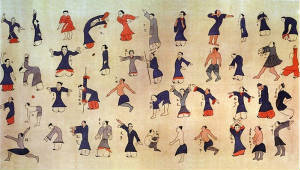
|
| Tomb excavated, circa 168 BC |
Dao Yin Tu: The 'Guiding and
Pulling' Chart
One of the earliest bonefide
documents of recorded 'longevity-health' exercises was found in the Nobel Tombs at Mawang Dui, Changsha Kingdom, 3rd century
BCE to 1st century CE.
"This chart was
found in Mawangdui Tomb No. 3. It shows forty-four people—men and women, young and old—engaged in a kind of gymnastics
believed to heal some diseases and extend life. The chart is considered the ancestor of the exercises called qigong practiced
today in China and all over the world."
“Guiding and pulling” (Daoyin) refers to the different
postures involved in these exercises. The physical basis for daoyin is qi. In the last centuries before the beginning of the
Common Era the Chinese came to believe that the whole world and everything in it was made of qi. Qi was the basis of Chinese
medicine. Wellness was the result of qi circulating freely throughout the body. Exercises could help qi circulate properly."
"The philosopher
Zhuangzi (4th century BCE) criticized those merely interested in extending life through exercise. In the process he gives
readers the names of some exercises:
“To huff and puff, exhale and inhale, blow out the old breath and take in the
new, do the ‘bear stride’ and the ‘bird stretch,’ and to be interested in nothing more than longevity,
these are the methods of those who practice the ‘guiding and pulling (of the vital breath) (daoyin)’” (Zhuangzi
15; Roth 1999: 170).
Reference:
Tao
Yin Longevity Exercises of Chen Tuan :
陳摶 導引
Seasonal
Tao Yin Exercises : Chen Tuan 陳摶 , or Master Xi-yi 希夷先生 allegedly linked
24 form sitting Tao-yin 'health' exercises for the seasons :
二十四 氣導引 坐功 圖 勢
er4-shi2-si4 chi4 tao4-yin3 zuo4-gong1 tu2 shi4
which
is linked to Eight Pieces of Brocade ( Baduanjin ), 八段錦
[
Note: unfortunately 8 of its exercises are nearly identical to the 10-12 exercises claimed as from Shao-lin Temple
which existed much earlier. ]
| Chen Tuan creation: |

|
| Water over Fire |
| Derived from Water over Fire |
|
|
| Trigram symbols |
| Orbiting 'fish' symbolic depiction of yin-yang |

|
| by Neo-confucian scholar Zhu Xi [1130-1200] |
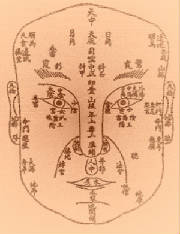
ChenTuan Physionomy :
Face-reading, fortune-telling. 陳摶本相
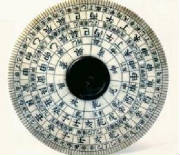
Fortuous
Geometrics : Chen Tuan and Geomancy:
Feng
Shui [wing / water] 陳摶風水
Positioning of 'house and gardens' Luck making.
Chen Tuan, Master Xi-yi and music : There does
exit many musical pieces that are 'claimed' to be from or 'derived' from or are 'honorific' to Msr. Chen. There is not a single
one of these that can be claimed bone fide. There exist often verse lines within the music that may also 'honor' Msr
Chen. See John Thompson at site: http://silkqin.com and Song Dynasty verses and songs.
|

